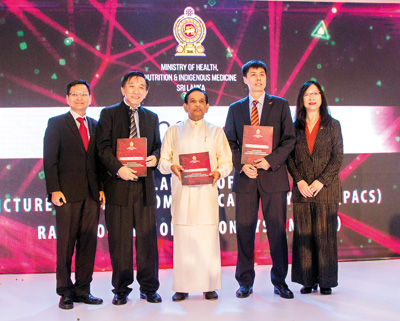New era of digital healthcare in Sri Lanka
View(s):The Ministry of Health is partnering with the global experts REDtone MEX Sdn Bhd – a subsidiary of Berjaya Corporation, Malaysia and Hinacom Software and Technology, China, an industry leader in Medical imaging and Telemedicine, to introduce cutting edge, Artificial Intelligence-based technology to 20 main government hospitals islandwide.

From left - Lau Bik Soon - Group CEO (REDtone MEX International), Kar Fong - CEO (REDtone MEX), Dr. Rajitha Senaratne - Minister of Health, Nutrition and Indigenous Medicine, Tony Cui - CEO (Hinacom) and Ms. Yi Isabelle Sun - Co-Founder Executive Vice President (Hinacom).
This landmark project which costs approximately Rs. 5.9 billion is spearheaded by the Minister of Health, Nutrition and Indigenous Medicine Dr. Rajitha Senaratne and supported by Health Ministry Secretary Ms. Wasantha Perera and the Additional Secretary (Development) Janaka Chandraguptha.
“It makes a mark in the history of medical imaging in Sri Lanka by bringing the vast benefits of teleradiology to the public health sector,” the Malaysian company said in a media release.
In the first phase of this revolutionary project, this partnership of global and local experts will establish a Teleradiology Command Centre at the National Hospital of Sri Lanka (NHSL) providing facilities completely free of charge. The Command Centre will be linked to hospitals around Sri Lanka.
The local healthcare industry has been coping with various challenges, including medical care delivery turnaround time, rapid changes and adoption of expensive diagnostic technology, large digital storage needs and rising costs. Utilising the innovative Picture Archiving Communication System (PACS) and Radiology Information System (RIS) digital platforms, the Centre will facilitate enhanced medical imaging services, increasing efficiency as well as bringing considerable cost savings to the public health network in Sri Lanka.
The PACS and RIS is a Medical Imaging platform that will enable the digital transformation of medical facilities around the country. This highly effective online platform utilises software and hardware which allows real-time system reporting with lossless images. It also provides economical storage, presentation, retrieval, distribution, and management of medical images. Transmission of electronic images and reports takes place digitally; so, manual filing, retrieving and distribution of film jackets are no longer required. It allows storage and viewing of all types of medical imaging by healthcare organisations both internally and externally.
PACS is generally deployed with RIS which provides electronic management of imaging departments – its major function being patient scheduling, resource management, examination performance tracking, reporting, results distribution and procedure billing. Critical for the efficient workflow of radiology practices RIS also complements HIS (Hospital Information Systems) as well as PACS.
“Not just a replacement for conventional x-ray methods, PACS offers exceptional return on investments with overall improvement of efficiency and long-term cost savings, as well as countless advantages for medical professionals, which in turn, brings benefits to patients,” the release added.


